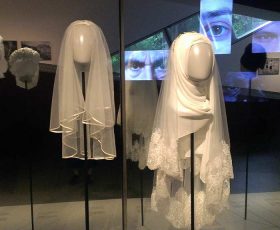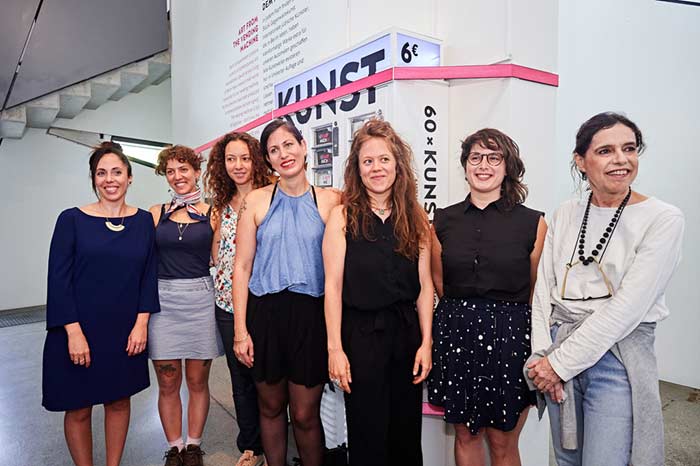The Italian Writer Elena Loewenthal Reflects on Strong Jewish Women in the Torah
The current exhibition Cherchez la Femme, which explores religious dress codes for women from women’s perspectives, remains on display until 27 August (more about the exhibition on our website). When I first found out the exhibition’s theme, I immediately thought of the novel Attese (2004) by the Italian author Elena Loewenthal. (The title means either “expectations” or “times of waiting.”) In four extended sections, the novel tells the stories of different Jewish female characters throughout the ages. But the novel’s real main character is a mysterious veil that follows the protagonists from Biblical times to modern-day Venice.

Veils in the exhibition Cherchez la femme; Jewish Museum Berlin, photo: Mirjam Bitter
We can read the veil as a metaphorical vessel of Jewish memory that women have guarded and passed on, a vessel that embodies recollection and forgetting, tradition and renewal. Indeed, the reasons each woman in the novel dons the veil are not only cultural (such as marking mourning) but personal: each of them reshapes it, sews in her own threads, or at least cultivates an idiosyncratic relationship with the garment she inherited. → continue reading
Last round (for now) for the art vending machine
It is one of our museum’s little success stories: this year will see the art vending machine’s fifth (and, for now, last) tour of duty in the permanent exhibition. After five years “Art from the Vending Machine” will have sold over 12,250 works. Maren Krüger, curator of the permanent exhibition, explains its achievement thus: “We know that visitors enjoy taking something away with them, that they like surprises and are interested in the present time. In addition, we want a permanent exhibition that’s alive, that always offers something new. That’s how the concept emerged.”

The artists of the fifth round of the art vending machine; Jewish Museum Berlin, photo: Yves Sucksdorff
As with all projects that work well, a number of people were involved. First of all, there’s Christiane Bauer, our former colleague who supplied the idea. She was inspired by the art vending machines at the Kunsttick Agency, which can now be found all over Germany. In fact, while searching online for a suitable model, she came upon an old vending machine from the 70s that stood in a sports center in the Rhineland-Palatinate province. First though, it had to be transported to Berlin… → continue reading
Ghetto Life and Beautiful Shoes

Wei Zhang looking at shoes “made in China”, which are part of the Jewish Museum Berlin’s collection; permanent loan by Marion Schubert, née Salomon; Jewish Museum Berlin, photo: Christoph Kreutzmüller
As a student studying the Holocaust at the University of Haifa, I was honored to do a short-term internship at the Jewish Museum Berlin with the team working on the new permanent exhibition. Before it began, I came across a small passage in the book Jewish Responses to Persecution: 1938–1940 (ed. by Jürgen Matthäus, Alexandra Garbarini, Plymouth: AltaMira Press, 2010) written in late 1938, directly after the November pogroms, that illustrated the desperation of German Jews (especially those in Berlin):
“There is one Jewish café open in Berlin. Anyone who wants to see what likely suicides look like should enter this café. The conversation of people sitting there revolves round two topics: how to obtain a passage to Shanghai or how to commit suicide.”
A question came to my mind: Could I find something related to Shanghai, the city where about 20,000 Ashkenazi Jews found refuge, here? As I started my research in the museum’s collection, I was excited to find an abundance of such information. Now I would like to share these stories with you. → continue reading


